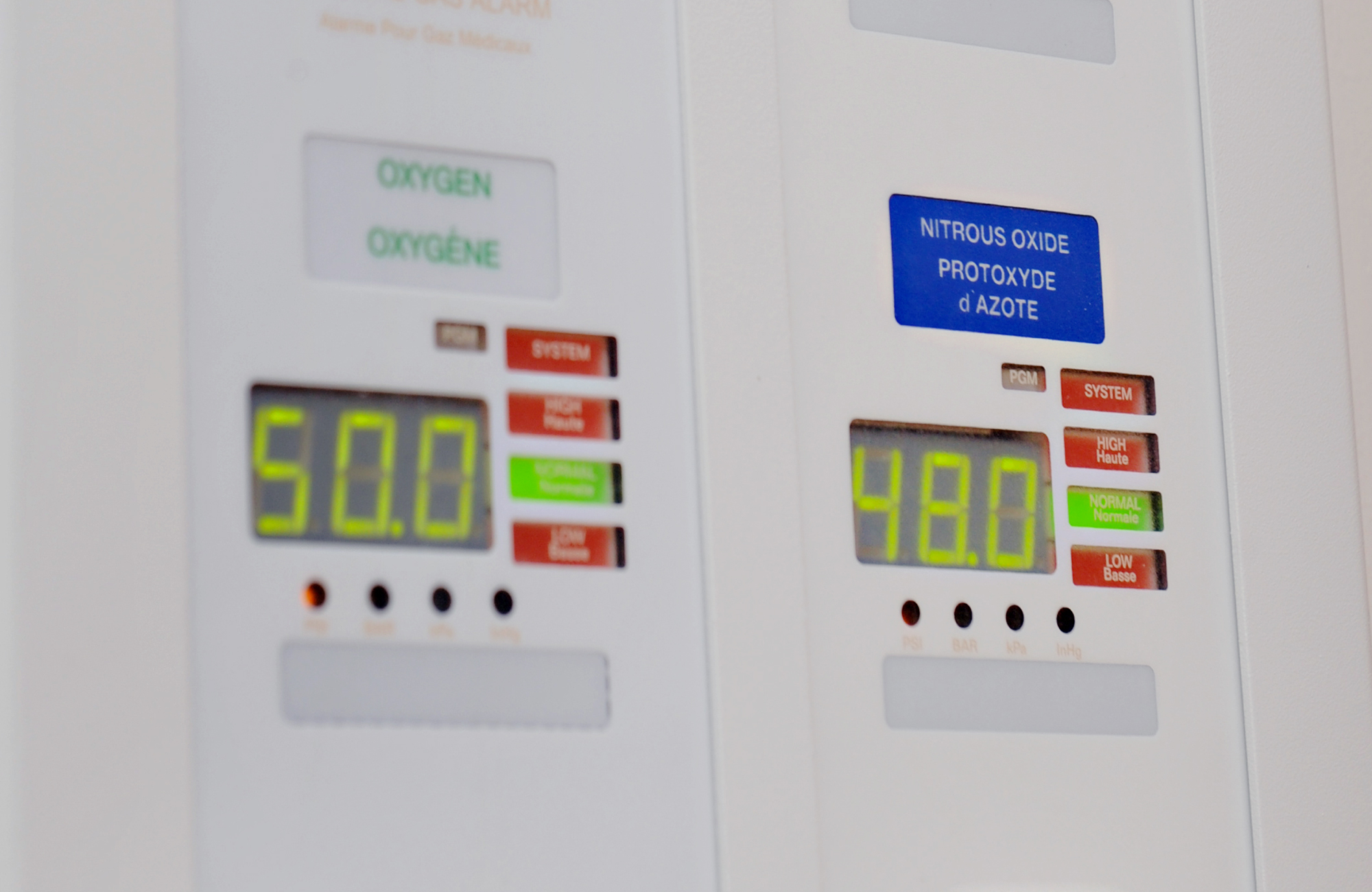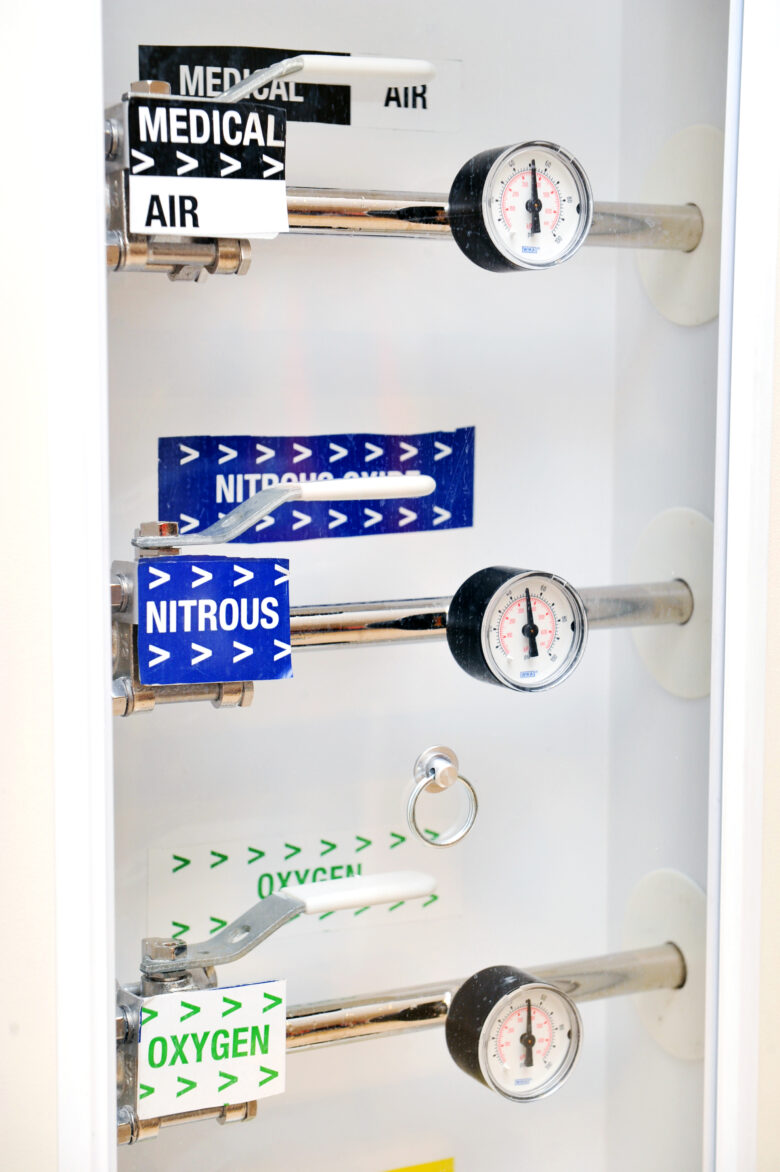
N2O exists in the atmosphere, measured at about 330 PPB in 2020 and is increasing yearly. It is a scavenger of stratospheric ozone and is considered to have a negative impact on the environment similar to CFC refrigerants.
Background
Historically, N2O has been used in healthcare facilities (“HCF”) for anesthetic and/or analgesic purposes:
(1) Anesthetic use has often been as the “carriergas” for delivery of vaporized anesthetic agents (Sevoflurane, Isoflurane and Desflurane as examples) to a patient using a breathing circuit and undergoing general anesthesia, (2) Analgesic use has traditionally been for pain management and can be clinician- or patient administered (for example, by expectant mothers breathing N2O to reduce pain associated with contractions). Typically, it does not require the use of a breathing circuit (anesthetic machine) as the patient will be conscious while directly expelling the N2O into the room instead of into a breathing circuit. While N2O continues to have clinical application, there has been a significant shift to reduce its use, particularly in surgical settings, in favour of more environmentally-friendly anesthesia techniques.
N2O Consumption and Leakage Concerns
As HCF’s continue to grapple with reducing emissions, N2O has again come under the spotlight. In the US, the healthcare sector is responsible for an estimated 8.5% of US greenhouse gas emissions(1). Further, medical gases contribute up to 40% of hospitals’ direct emissions(2), with N2O pipeline leakage alone contributing upwards of 90% of the N2O consumption when measured against actual clinical consumption use. It has been known for some time that most centrally piped N2O pipeline leakage occurs through the plastic hoses used in ceiling arms (aka booms, articulating arms, ceiling pendants) that can move vertically and horizontally, as well as the plastic hoses supplied with equipment that connect to a terminal unit (outlet). N2O is known to permeate these plastic hoses. The leakage of N2O through the plastic hose is typically across its entire length. Teflon pigtails used to connect nitrous oxide cylinders to a cylinder manifold have also been found to leak, but the CSA Z7396.1 standard banned the use of polymer-lined flexible metallic pigtails for pressure gases in favor of copper pigtails.

Health Effects of Exposure to N2O
Studies have reported adverse health effects for workers exposed to N2O. These include reduced fertility, spontaneous abortion, and neurological, renal and liver disease(1). Patient and clinical staff health effects can also include nausea and vomiting(1). There have been studies on acute and chronic exposure to individuals or groups inside a HCF(4). The results indicate a significant difference in health effects for groups exposed to N2O which include headaches, dizziness, nausea, vomiting, euphoria and tachycardia (heart rate > 100 bpm).
Recent Opinion from the Canadian
Anesthetists Society on N2O Usage
In 2024, the Canadian Anesthesiologists’ Society (CAS) issued their revised edition of Guidelines to the Practice of Anesthesia.(5) In this guideline, Section 10 (page 31 Guidelines for Environmental Sustainability), indicates the following points with regard to N2O:
“The use of desflurane and N2O should be eliminated or minimized to the extent possible given local resources, locations, and the clinical context.”
“Environmentally-friendlier anesthesia techniques such as neuraxial/regional anesthesia and total intravenous anesthesia may be considered as alternatives to volatile inhalational anesthesia to minimize greenhouse gas burden when clinically appropriate, feasible, and available.”
Recent Opinion from the Association des anesthésiologistes du Québec (AAQ)
On April 25, 2024, the AAQ(3) issued the following statement: AAQ aposition statement on N2O pipelines The Association des anesthésiologistes du Québec Board of Directors, representing the largest traditional users of medical N2O, has unanimously taken a position on N2O pipelines in hospitals on April 25:
“The AAQ supports decommissioning central N2O pipelines in existing hospitals, no longer installing them in new hospitals, and, if necessary, working with N2O cylinders.”
Furthermore, the elimination or minimization of N2O from anesthetic practice has been a recommendation of the Canadian Anesthesiologists’ Society’s Guidelines to the practice of anesthesia since 2023.
Recommendations
Given the opinions from the CAS and AAQ to pivot away from using N2O in favour of other friendlier anesthesia techniques, and coupled with the known leakage concerns from centrally piped N2O pipeline systems, an opportunity exists for HCF’s to reevaluate with their anesthesiology department stakeholders the clinical use of N2O and the delivery method. Reevaluating N2O usage and delivery methods also aligns with Annex P recommendations in CSA Z7396.1 medical gas standard.
Disclaimer
HH Angus cannot provide any opinion on the clinical use of N2O as this is a medical issue. This client advisory serves only to highlight recent opinions and studies on known problems associated with the leakage of N2O from centrally piped medical gas pipeline systems, as well as the recommendations from the CAS and AAQ. The HCF must make its own determination on the suitability of continued clinical use of N2O and the associated delivery methods.
Reference Sources
1. Decommissioning N20 Playbook - WORKING VERSION.docx (practicegreenhealth.org).
2. Collaborating to prevent nitrous oxide waste in medical gas systems_FINAL 5-2-2023.pdf (practicegreenhealth.org)
3. https://mcusercontent.com/195cedfbb43cfc829ac342437/files/d239380c-8484-d56a-92b4-c50f920bd63a/Prise_de_position_AAQ_N2O.03.pdf
4. https://www.ncbi.nlm.nih.gov/pmc/articles/PMC5661723/
5. https://www.cas.ca/CASAssets/Documents/Practice-Resources/Guidelines/CAS_Final_Guidelines_2024.pdf
For More Information
Edward Hood, P.Eng.
Principal | Engineering Director, Health
Edward.Hood@hhangus.com
